Dogs are beloved companions in countless homes, bringing joy and unconditional love to their families. However, for many individuals, the presence of canine allergens can make living with a furry friend a challenging endeavor. This often leads people to seek out “hypoallergenic” dog breeds, believing they offer a solution to allergy concerns. Understanding which dog breeds minimize shedding and reduce allergen exposure is key to a harmonious home for allergy sufferers, and can open up the wonderful world of dog ownership. different types of dog breeds exist globally, each with unique characteristics that might suit different households.
While the term “hypoallergenic” is widely used, it’s crucial to understand that no dog is entirely allergen-free. All dogs produce allergens, primarily through dander (dead skin cells), saliva, and urine. What makes certain breeds more suitable for people with allergies is their tendency to shed less hair and, consequently, release fewer airborne allergens. This reduction in shedding can significantly mitigate allergic reactions like coughing, itching, or wheezing, making these breeds a more manageable option for sensitive individuals.
What Makes a Dog “Hypoallergenic”?
The concept of a “hypoallergenic dog” generally refers to breeds that are less likely to trigger allergic reactions in humans. This is largely due to their coat type and the amount of dander they produce. Dogs with hair that grows continuously, rather than shedding frequently, tend to trap dander and loose hairs within their coat, preventing them from spreading throughout the environment.
These dogs still produce allergens in their skin, saliva, and urine, meaning that strict hygiene practices for both the dog and the home are essential for allergy sufferers. The goal is to minimize the spread of these allergens, making the living environment as comfortable as possible.
Top Dog Breeds Which Don’t Shed Hair
For those seeking canine companionship without the constant battle against shedding and allergens, a variety of dog breeds offer promising solutions. These breeds often feature unique coats that minimize the release of dander into the home. Here are some of the best dog breeds known for their low-shedding qualities, making them excellent choices for individuals with allergies.
1. Poodle
Poodles are renowned for their elegance, intelligence, and their low-shedding coats. Available in three sizes—Standard, Miniature, and Toy—each Poodle type boasts a dense, curly coat that sheds minimally. Originally bred as water retrievers, their coat is designed to protect them from the elements. Due to their non-shedding nature, Poodles require regular grooming to prevent matting, including brushing and professional clipping every 4-6 weeks. Their keen intelligence also makes them highly trainable and a joy to live with.
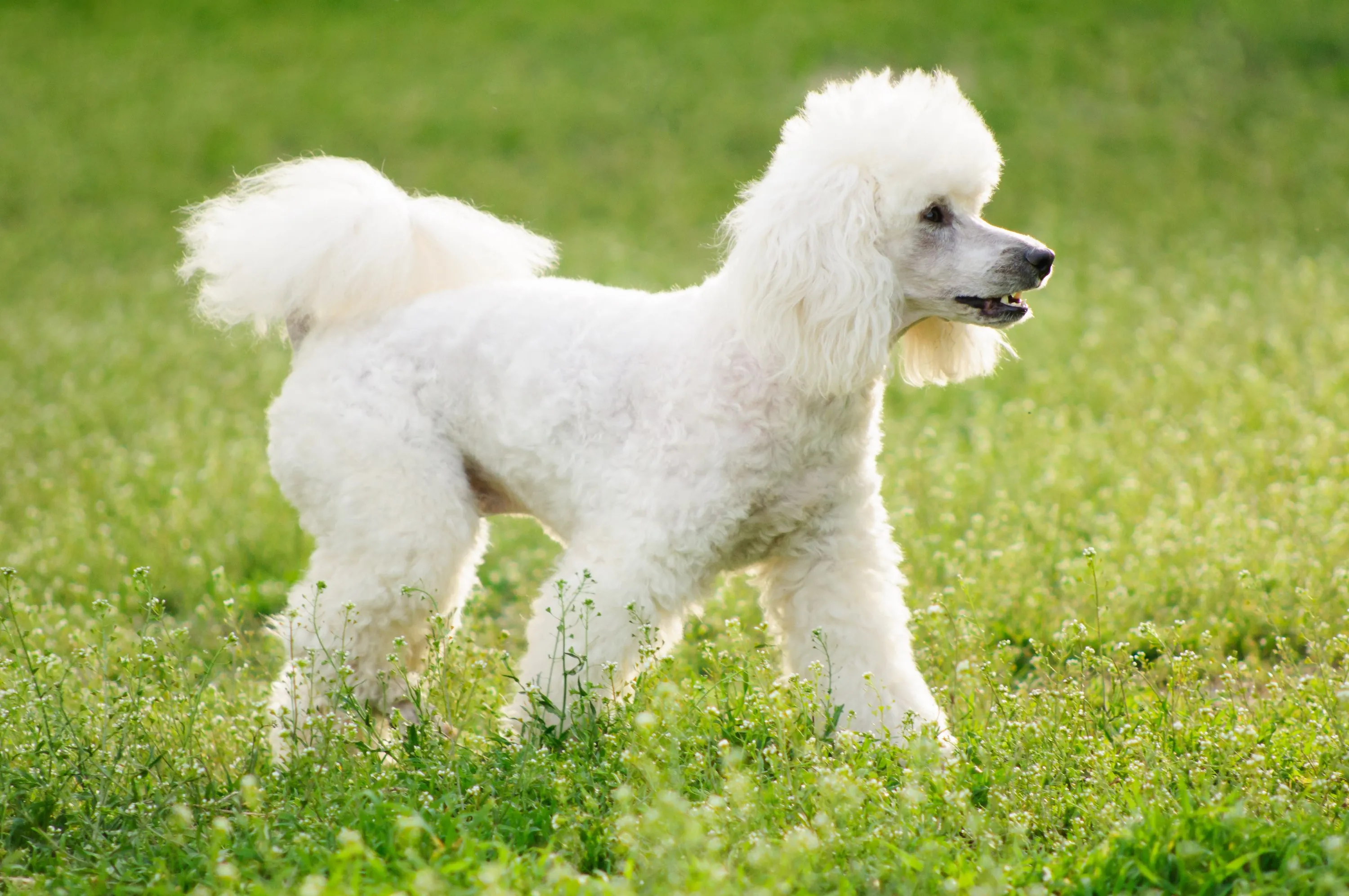 White Standard Poodle standing gracefully in a grassy park setting
White Standard Poodle standing gracefully in a grassy park setting
2. Yorkshire Terrier
The spirited and affectionate Yorkshire Terrier, or “Yorkie,” is a small breed with a long, silky coat that is more like human hair than typical dog fur, leading to minimal shedding. These cute hypoallergenic dogs are known for their spunky yet loving personalities and can adapt well to various living situations, from spacious homes to compact apartments, provided they receive ample attention. Regular brushing is necessary to keep their fine coats free of tangles and mats. white cute dog breeds in India are often sought after, and while Yorkies can be found there, they are generally known globally.
3. Shih Tzu
Shih Tzus are ancient companion dogs celebrated for their luxurious, flowing coats and friendly temperaments. Despite their thick hair, Shih Tzus are low-shedding, making them a popular choice for allergy sufferers. Their flat faces can predispose them to certain health issues, such as breathing difficulties and overheating, as well as tear stains. Regular grooming, including daily brushing and eye-cleaning, is crucial to maintain their coat and overall health.
 Brown and white Shih Tzu lying calmly on a living room floor
Brown and white Shih Tzu lying calmly on a living room floor
4. Miniature Schnauzer
The Miniature Schnauzer is the smallest of the three Schnauzer breeds, characterized by its distinctive wiry coat and bushy eyebrows and beard. These intelligent and robust dogs stand no more than 14 inches tall and typically weigh between 10-20 pounds, fitting well into diverse household environments. Their low-shedding coat requires regular grooming, including hand-stripping or clipping, to keep it in prime condition. Miniature Schnauzers are energetic and need at least an hour of exercise daily to stay happy and well-behaved.
5. Standard Schnauzer
Slightly larger than their miniature counterparts, Standard Schnauzers share many desirable traits, including their low-shedding, wiry coats. Weighing up to 45 pounds, these dogs are energetic and thrive on physical activity. They love engaging in long walks, games of fetch, and problem-solving activities with dog puzzle toys. Their intelligence and affectionate nature make them excellent family pets, provided their exercise needs are met.
6. Giant Schnauzer
As the largest of the Schnauzer breeds, Giant Schnauzers can reach over 27 inches in height and weigh up to 85 pounds. Despite their imposing size, they are considered hypoallergenic due to their non-shedding, dense double coat. These powerful dogs require significant amounts of exercise to channel their energy positively, enjoying activities like long walks, runs, hikes, and active games of fetch. Proper training and socialization from a young age are essential for these intelligent and loyal companions.
7. Bichon Frise
The Bichon Frise is a cheerful, playful, and affectionate small dog known for its curly, powder-puff white coat that sheds minimally. Their highly intelligent and trainable nature allows them to quickly master basic commands and even learn advanced tricks. Bichons thrive on companionship and are generally good with children and other pets, making them a wonderful addition to many families. Regular grooming is essential to prevent their soft, curly coat from matting. Some popular dog breeds in India include small breeds, and while the Bichon is not native, its low-shedding qualities are universally appealing.
8. Chinese Crested
The Chinese Crested is a small, distinctive breed known for its unique appearance, which comes in two varieties: hairless and powderpuff. The hairless variety has smooth skin with tufts of hair on its head, tail, and paws, while the powderpuff is covered in a soft, silky coat. Both varieties are considered hypoallergenic. These dogs are playful, affectionate, and make devoted companions. Due to their minimal shedding, they are a good option for those with allergies, though the hairless variety requires skin care to prevent sunburn and dryness.
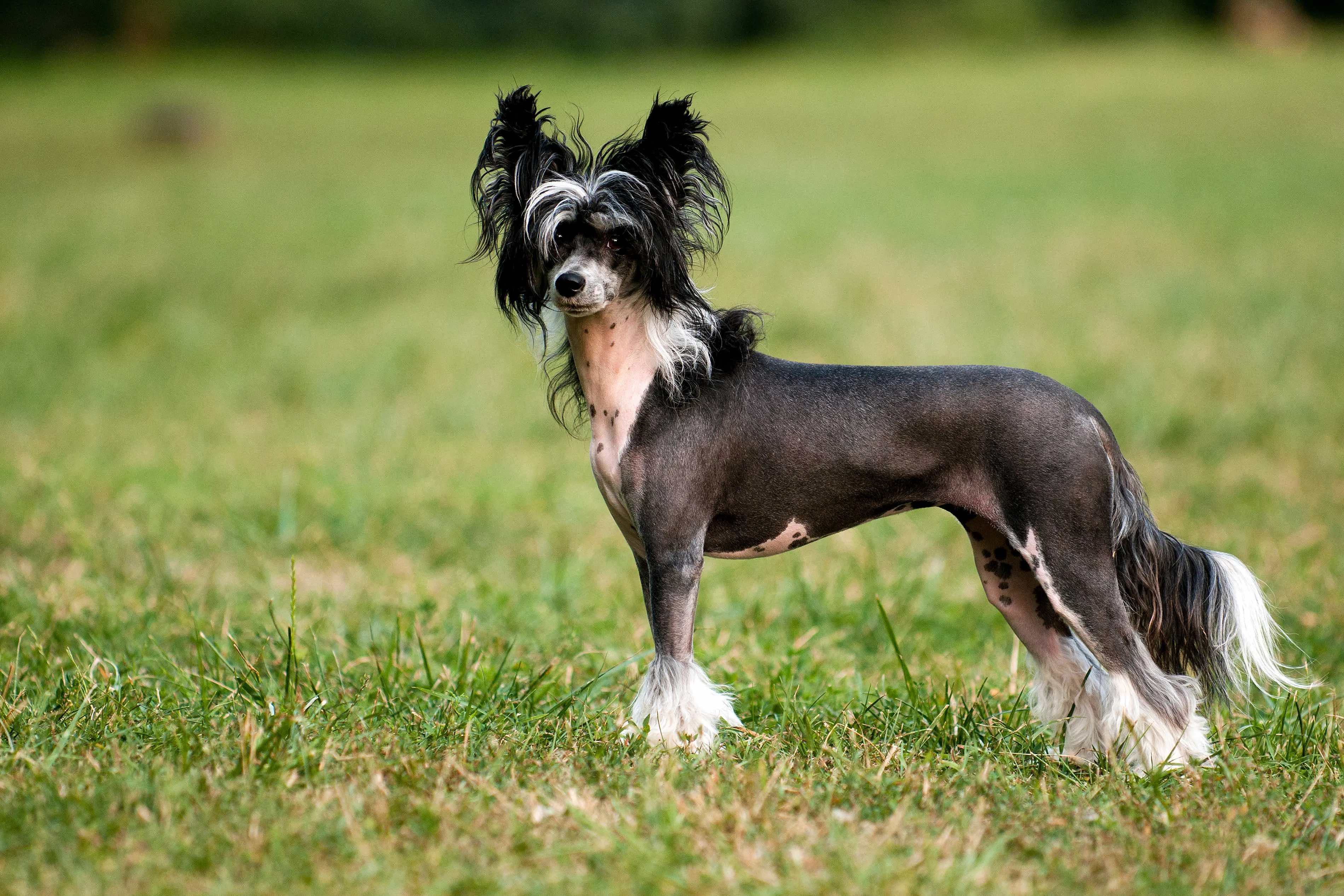 Black hairless Chinese Crested dog looking intently at the camera
Black hairless Chinese Crested dog looking intently at the camera
9. Portuguese Water Dog
Originally bred to assist fishermen in Portugal, the Portuguese Water Dog is a medium-sized breed with a robust, curly coat that sheds very little. These intelligent, highly trainable, and friendly dogs are known for their high energy levels and love for water. Regular exercise, including swimming, is crucial to keep them physically and mentally stimulated. Their distinctive coat requires consistent grooming to prevent matting and maintain its health.
10. Labradoodle
A crossbreed between a Labrador Retriever and a Poodle, the Labradoodle was initially developed to be a hypoallergenic service dog. They inherit the intelligence and friendly disposition of both parent breeds, making them excellent family pets. Labradoodles are highly trainable and generally gentle, especially when well-socialized and exercised from an early age. Their low-shedding coat can vary in texture, from wavy to curly, and requires regular grooming.
11. Goldendoodle
Goldendoodles are another popular “doodle” breed, a cross between a Golden Retriever and a Poodle. Like Labradoodles, they are cherished for their friendly nature, high intelligence, and low-shedding coats. While often recognized for their golden hues, Goldendoodles come in a wide range of colors and coat textures. They require frequent grooming with a slicker brush to prevent matting, ensuring their beautiful coats remain healthy and manageable. Many owners prioritize finding white dog breeds with price information, and Goldendoodles can come in lighter shades, appealing to this preference.
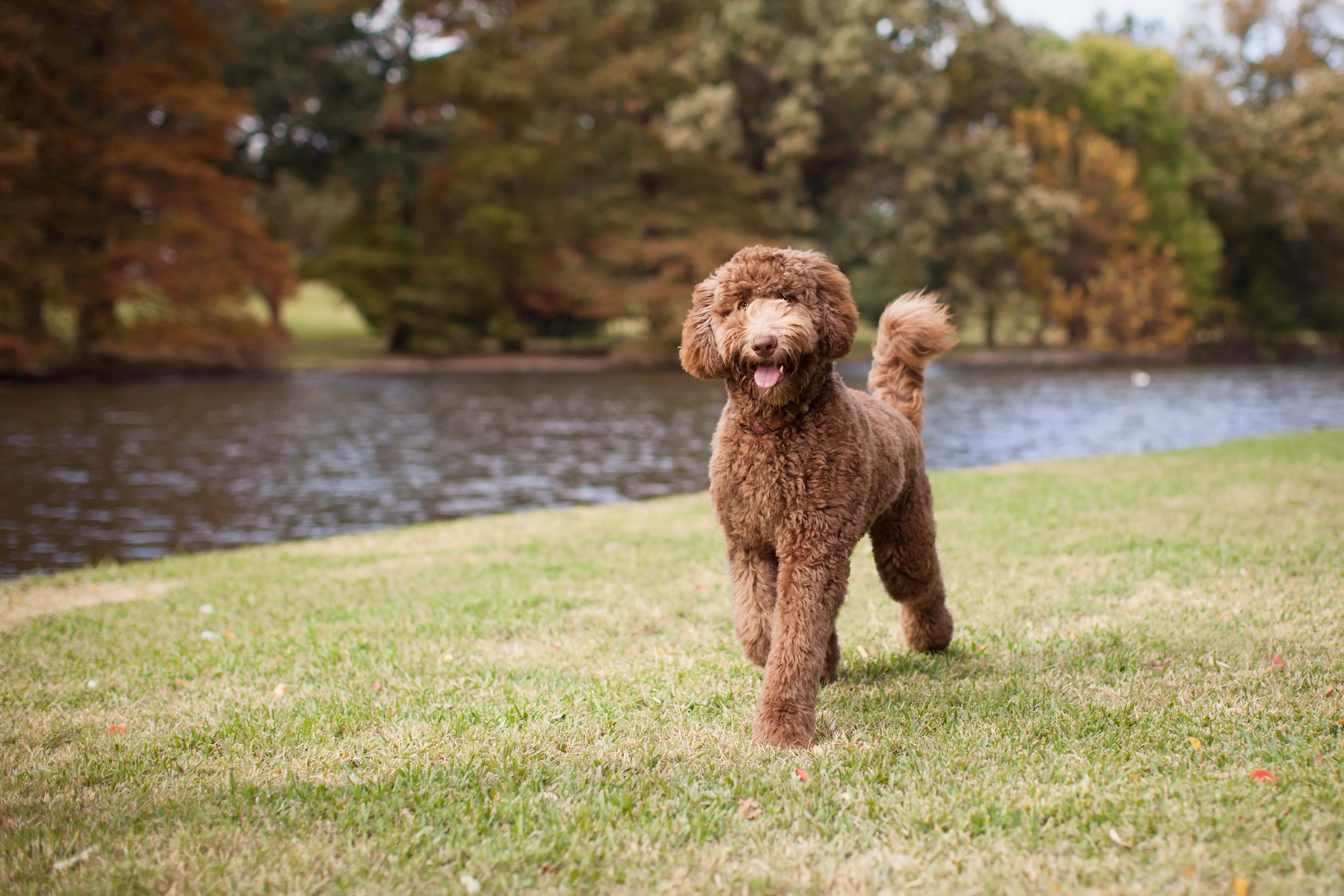 Brown Standard Goldendoodle dog walking happily through a lush green park
Brown Standard Goldendoodle dog walking happily through a lush green park
12. Lagotto Romagnolo
Hailing from Italy, the Lagotto Romagnolo was originally bred as a water retriever, and their thick, woolly, curly coat served as protection in chilly waters. Although less common than some other hypoallergenic breeds, Lagotti Romagnoli (the plural form) are known for being good with children and other pets, making them suitable family dogs. Their unique coat sheds minimally but requires regular trimming and grooming to prevent matting and keep them comfortable.
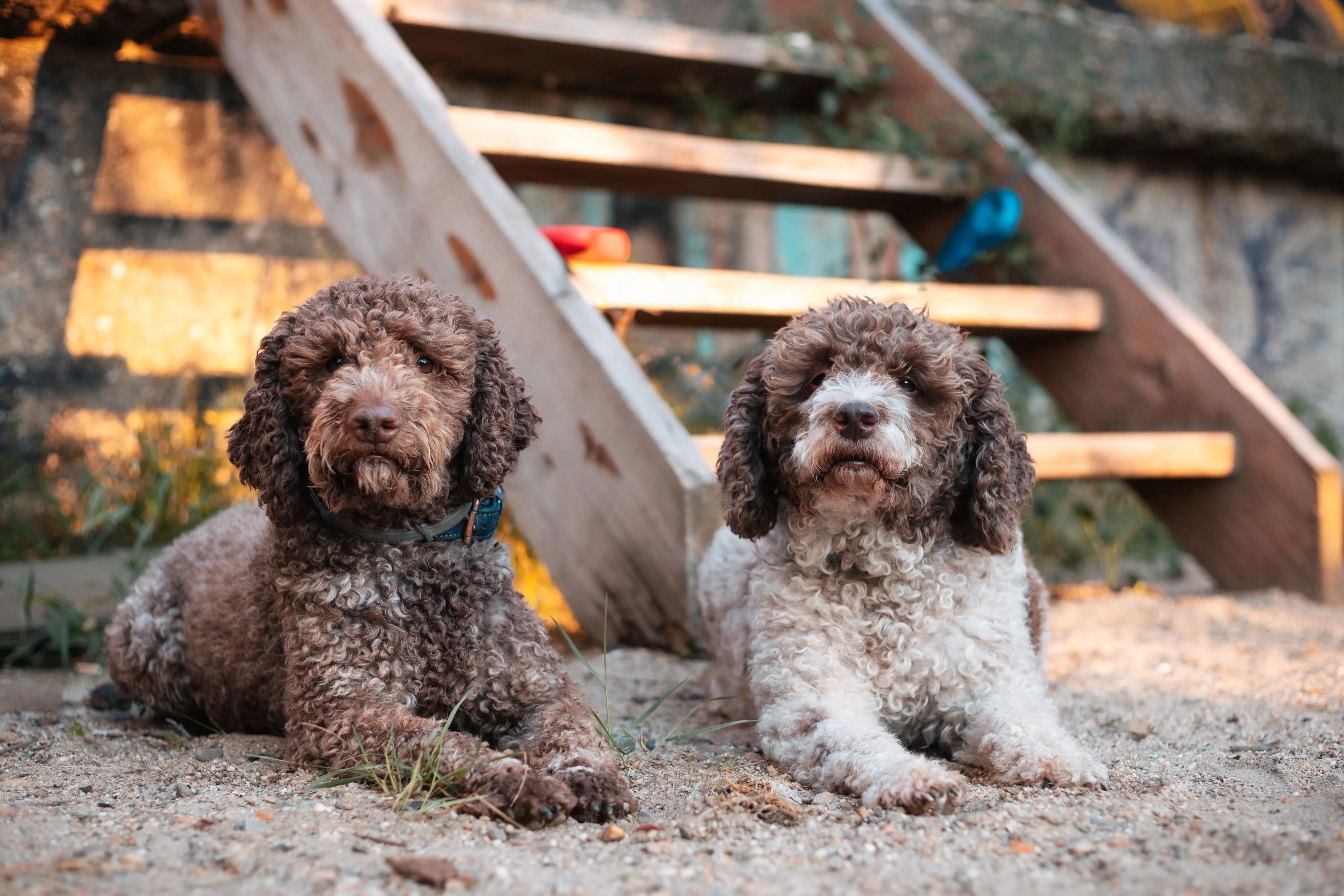 Two Lagotto Romagnolo dogs with curly, woolly coats lying on the ground, looking alert
Two Lagotto Romagnolo dogs with curly, woolly coats lying on the ground, looking alert
13. Affenpinscher
Affenpinschers are small, charming dogs known for their distinctive monkey-like facial expression. Their dense, wiry coat produces fewer allergens compared to many other breeds, classifying them as hypoallergenic. This unique coat demands dedicated care, including regular at-home brushing and hand-stripping, a grooming technique where hair is removed from the root rather than simply trimmed, to maintain its texture and health.
14. Irish Water Spaniel
The Irish Water Spaniel is a friendly, intelligent, and highly trainable water dog breed, originally used for retrieving game. They possess a thick, curly coat that is always liver (brown) in color and sheds minimally, making them a good choice for allergy sufferers. Their high energy level necessitates regular exercise to keep them happy and healthy, ensuring they remain well-behaved companions. Consistent grooming is also vital to manage their dense coat.
15. Aussiedoodle
A delightful cross between an Australian Shepherd and a Standard or Miniature Poodle, the Aussiedoodle is a highly intelligent and energetic hypoallergenic dog. They inherit their sharp minds and zest for life from both parent breeds. To prevent boredom, which can lead to destructive behaviors, Aussiedoodles require ample exercise and consistent mental stimulation through enrichment toys like treat dispensers. Their coat varies and needs regular grooming to maintain its low-shedding qualities.
16. Bolognese
Originating from Italy, the Bolognese is a charming small dog breed known for its long, fluffy white coat that, despite its somewhat messy appearance, is low-shedding. These playful and easygoing pups are reputed to get along well with children and other pets, adapting readily to various living situations. Despite their low-shedding coat, Bolognese require significant grooming to prevent matting and maintain their characteristic fluffy look.
17. Maltese
The Maltese is a small, ancient breed recognized for its luxurious, flowing white coat that is single-layered and sheds minimally. Maltese dogs make affectionate and playful companions for pet parents who are committed to their extensive grooming needs, especially if they wish to maintain their dog’s long hair. Many owners opt for a shorter “puppy cut” to simplify grooming, which can be easily managed with dog hair grooming clippers. For those interested in dog breeds with pictures and names that are particularly elegant, the Maltese is a prime example.
18. Soft Coated Wheaten Terrier
The Soft Coated Wheaten Terrier is a medium-sized Irish breed distinguished by its incredibly soft, silky coat that sheds very little. True to their terrier heritage, Wheatens possess a high energy level throughout their lives, necessitating abundant exercise and mental stimulation to ensure their best behavior. Their unique coat requires consistent grooming to prevent tangles and maintain its signature soft texture.
19. Coton de Tulear
Originating from Madagascar, the Coton de Tulear is a small, easygoing hypoallergenic breed. Their name, meaning “cotton of Tulear,” refers to their soft, cotton-like coat that sheds minimally. Their good-natured disposition makes them excellent companions for families with children and other pets, particularly when introductions are handled properly. Cotons are affectionate and thrive on close companionship.
20. Schnoodle
The Schnoodle is an interesting “doodle” breed that combines two already hypoallergenic breeds: the Schnauzer and the Poodle. This unique lineage results in a dog whose coat can be curly or wavy, depending on the genes inherited from its parents, but consistently low-shedding. Schnoodles are known for their intelligence, playful nature, and adaptability, making them versatile family members that require regular grooming to keep their coats healthy.
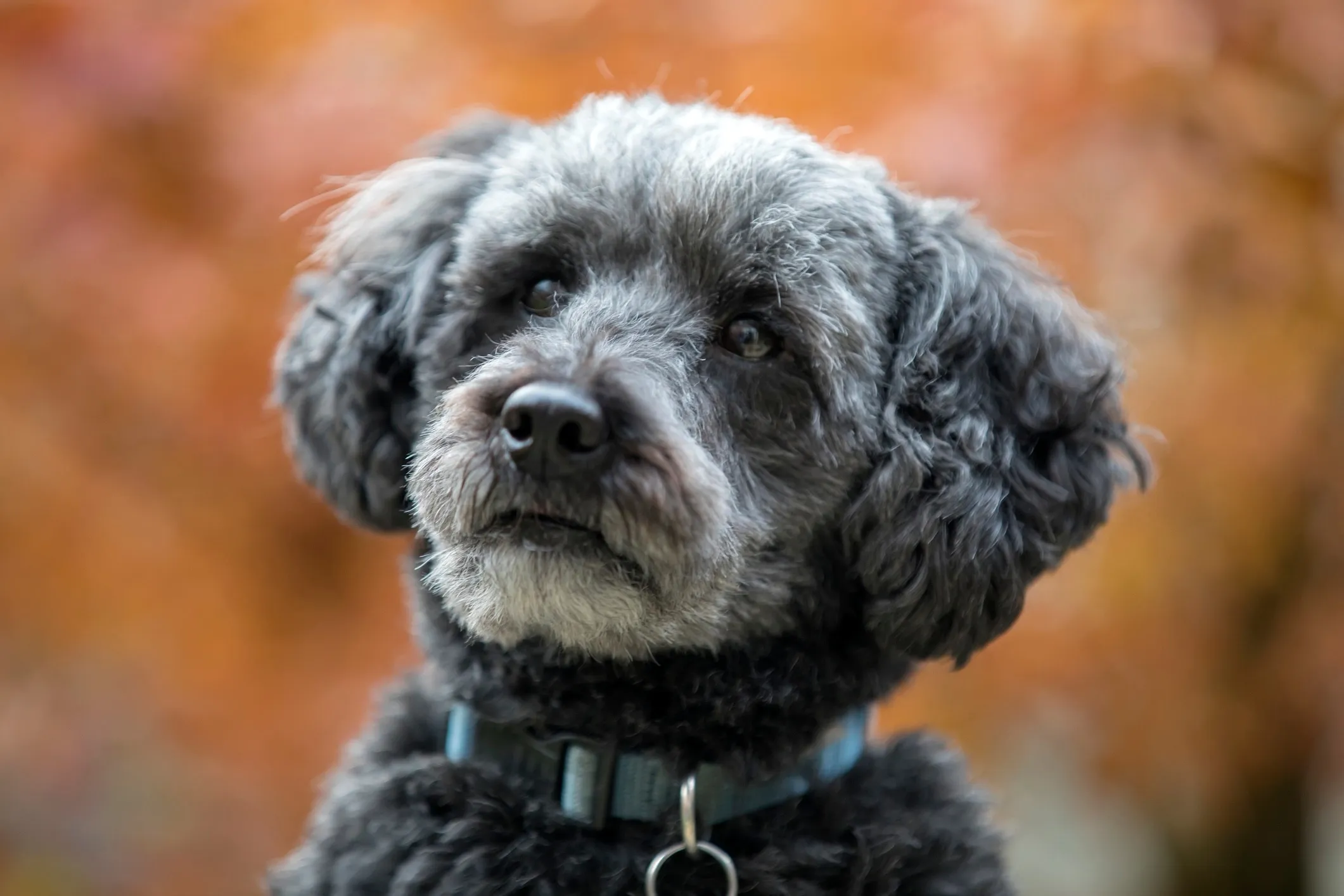 Gray Schnoodle dog with a curly coat, shown in a close-up portrait
Gray Schnoodle dog with a curly coat, shown in a close-up portrait
21. Bedlington Terrier
Often described as “a lamb in dog’s clothing,” the Bedlington Terrier is a small, curly-haired breed with a distinctive topknot and pom-pom ear tufts. This unique appearance complements their loving personality; they adore being close to their human companions. Bedlington Terriers can be prone to separation anxiety if left alone for extended periods, making them ideal for households where someone is usually home. Their low-shedding coat requires regular grooming to maintain its characteristic texture.
22. Xoloitzcuintli
The Xoloitzcuintli, or Mexican Hairless Dog, is one of the oldest and rarest dog breeds, considered hypoallergenic. It comes in three sizes (toy, miniature, and standard) and two varieties: hairless and coated (with a short, fine coat). Both are low-shedding. Hairless Xolos require specific skin care to protect them from sun and cold, while coated Xolos need minimal grooming. They are calm, intelligent, and loyal companions.
23. Whoodle
The Whoodle is a charming crossbreed resulting from the pairing of a Soft-Coated Wheaten Terrier and a Poodle. These friendly dogs inherit the low-shedding qualities and intelligence from both parent breeds. Whoodles are known for their affectionate nature and playful energy, making them excellent family pets. Their coat can vary in texture and requires regular grooming to prevent tangles and mats.
24. Bernedoodle
A cross between a Bernese Mountain Dog and a Poodle, the Bernedoodle is a large hypoallergenic dog celebrated for its friendly, affectionate, and gentle demeanor. These qualities make them a popular choice for families with children and other pets. Bernedoodles require ample exercise to remain active and content, thriving on outdoor activities and playtime with their families. Their wavy to curly coats are low-shedding but need regular grooming.
25. Shorkie
The Shorkie is a mixed breed resulting from the combination of a Shih Tzu and a Yorkshire Terrier, both of which are hypoallergenic breeds. This blend creates a small, playful, and friendly dog that embodies the best traits of its parent breeds. Like most low-shedding dogs, Shorkies require a commitment to a regular grooming routine to keep their fine coats healthy and free of mats.
26. Afghan Hound
Afghan Hounds are striking dogs, instantly recognizable by their long, flowing coats and slender, elegant builds. Despite their abundant hair, they are considered low-shedding, with a single coat that is more like human hair. These pups are built for speed and are among the fastest dog breeds. Afghan Hounds are loving toward their immediate family but can be aloof with strangers, necessitating early and consistent socialization to develop a well-adjusted temperament.
 Gray and tan Afghan Hound with long, flowing fur, looking dignified
Gray and tan Afghan Hound with long, flowing fur, looking dignified
27. Barbet
Pronounced “bar-bay,” the Barbet is a cheerful French water dog with a shaggy, woolly coat. The name “Barbet” originates from the French word barbe, meaning beard, a nod to the dog’s characteristically hairy chin. This large hypoallergenic dog loves to swim, thanks to its protective curly coat. To maintain its coat in good condition, especially after water activities, regular brushing with a slicker or pin brush two to three times a week is recommended.
28. Shih-Poo
The Shih-Poo is a charming mixed breed, typically a cross between a Shih Tzu and a Toy Poodle. This small pup is highly adaptable and can thrive in almost any living situation, provided they receive about 30 minutes of exercise and a good brushing session every day. Their low-shedding coat, which can be wavy or curly, requires consistent grooming to prevent tangles and mats, ensuring they remain comfortable and looking their best.
29. Peruvian Inca Orchid
Peruvian Inca Orchids are rare, ancient dog breeds that are naturally hypoallergenic due to their nearly hairless bodies. They are considered the national dog of Peru and come in three sizes: small, medium, and large. While most are hairless, some may have a very short coat. These elegant dogs require special care for their skin, particularly protection from sun exposure and cold temperatures, but their minimal hair means almost no shedding.
30. Malshi
A cross between the Maltese and Shih Tzu, the Malshi is a happy, small hypoallergenic dog. They are known for their affectionate nature and thrive on close companionship with their favorite humans. Malshis are playful and adapt well to various home environments. Like their parent breeds, they require a regular grooming routine to keep their soft, low-shedding coats healthy and beautiful.
Essential Tips for Living With a Dog That Doesn’t Shed Much
Bringing a low-shedding dog into your home is a fantastic step towards managing pet allergies, but it’s important to understand that ongoing care and maintenance are crucial for an allergen-minimized environment. Successfully living with a dog that doesn’t shed much requires a holistic approach that includes consistent grooming, meticulous home cleaning, and proactive health management.
Keep Up With Grooming
Regular grooming is paramount for hypoallergenic dogs to ensure their coat remains clean and to reduce the presence of dander. Ideally, your dog should be brushed several times a week, and bathed every four to six weeks. Using a specialized shampoo, such as Allerpet® Dog Dander Remover, can significantly help in neutralizing allergens present on your dog’s skin and coat.
Many low-shedding breeds also require regular trimming, and some even need hand-stripping, to maintain the health and texture of their unique coats. Factor in the budget for professional grooming services, or commit to learning and performing these grooming tasks at home. Consistent grooming not only keeps your dog looking great but also plays a vital role in controlling allergens.
Maintain a Clean House
Minimizing allergens extends beyond just your dog; it encompasses maintaining a clean and allergen-free home environment. Regular vacuuming with a HEPA filter, dusting surfaces, and washing bedding (both yours and your dog’s) are essential practices to reduce accumulated pet dander.
Additionally, utilizing air purifiers with HEPA filters can help remove airborne allergens, and ensuring your home is well-ventilated will further enhance air quality. Consider creating “allergen-free zones” in your home, such as bedrooms, where your dog’s access might be limited, allowing allergy sufferers a sanctuary from potential triggers.
Talk to Your Doctor
Managing your allergies while living with a dog, even a low-shedding one, is best done in consultation with your healthcare provider. Your doctor can offer personalized advice and prescribe treatments such as antihistamines, nasal sprays, or allergy shots (immunotherapy) to help manage symptoms effectively.
It’s also important to remember that allergens are present in a dog’s saliva and urine, not just their dander. Therefore, it’s wise to avoid close contact with your dog’s mouth and to wash your hands thoroughly after handling them or cleaning up after them. By combining medical advice with proactive home and pet care, you can significantly improve your quality of life with a beloved canine companion.
Bringing a dog that doesn’t shed much into your life can be a transformative experience for individuals with allergies, offering the joy and companionship of pet parenthood without constant allergic reactions. With the right breed choice and a dedicated approach to grooming and home maintenance, a happy and healthy life with your furry friend is entirely within reach.
